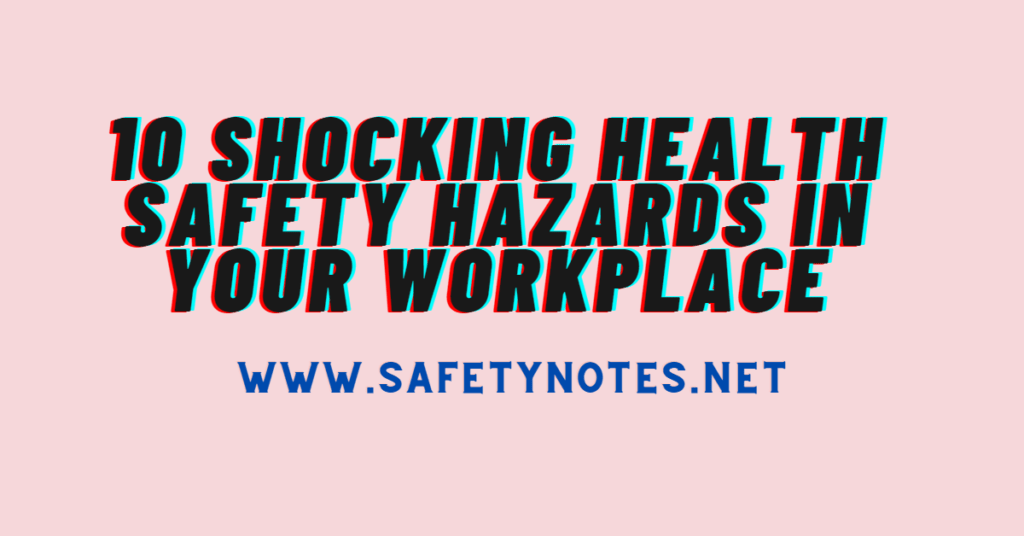Introduction
In this article, we’ll explore 10 shocking health safety hazards that could be lurking in your workplace and how to minimize their impact. Every day, millions of people head to work without giving much thought to the potential health safety hazards they may encounter. However, the truth is that many workplaces are filled with hidden dangers that can have serious consequences on our well-being.

The Hidden Dangers Lurking in Your Office
10 Shocking Health Safety Hazards in Your Workplace!
Poor Air Quality
Did you know that indoor air pollution can be up to five times worse than outdoor air pollution? Poor air quality in the workplace can lead to respiratory issues, allergies, and even chronic illnesses. Factors that contribute to poor air quality include inadequate ventilation, mold growth, and the presence of volatile organic compounds (VOCs) from cleaning products and office equipment.
Tripping Hazards
Loose cables, cluttered walkways, and slippery floors can all pose tripping hazards in the workplace. These seemingly innocuous obstacles can lead to severe injuries, including sprains, fractures, and even head trauma.
Ergonomic Issues
Prolonged sitting and poor posture can contribute to musculoskeletal disorders like carpal tunnel syndrome, back pain, and neck strain. Ergonomic issues are often overlooked, but they can significantly impact employee health and productivity.
Fire Hazards
Overloaded electrical outlets, faulty wiring, and improper storage of flammable materials can all create fire hazards in the workplace. Fires can lead to severe injuries, property damage, and even fatalities.
Electrical Hazards
Exposed wiring, damaged electrical equipment, and overloaded circuits can pose serious electrical hazards. These dangers can result in shocks, burns, and even electrocution.
Chemical Exposure
Many workplaces use chemicals for cleaning, maintenance, and production. Improper handling, storage, and disposal of these chemicals can lead to harmful exposure, causing respiratory issues, skin irritation, and long-term health problems.
Biological Hazards
Workplaces that handle food, waste, or medical materials may be at risk for biological hazards. Exposure to bacteria, viruses, and other pathogens can lead to illness and infection.
Noise Pollution
Excessive noise in the workplace can cause hearing damage, stress, and decreased productivity. Prolonged exposure to high noise levels can lead to permanent hearing loss.
Stress and Burnout
High-pressure work environments, unrealistic expectations, and long hours can contribute to stress and burnout. Chronic stress can lead to a host of physical and mental health issues, including heart disease, depression, and anxiety.
Inadequate Safety Training
Lack of proper safety training can put employees at risk for injury and illness. Comprehensive training is essential to ensure that workers understand potential hazards and how to prevent accidents.
How to Minimize Health Safety Hazards in Your Workplace
Implementing Safety Protocols
Establishing clear safety protocols and procedures is crucial for minimizing workplace hazards. Regular inspections, maintenance, and updates to safety equipment can help prevent accidents and injuries.
Encouraging Employee Awareness
Promoting a culture of safety includes encouraging employees to be aware of potential hazards and to report any concerns. Open communication and collaboration are essential for creating a safe working environment.
Regularly Assessing Workplace Hazards
Conducting regular workplace hazard assessments can help identify and address potential dangers before they become serious problems. These assessments should be thorough and involve input from employees at all levels.
Conclusion
Workplace health safety hazards are often overlooked, but they can have severe consequences on employee well-being and productivity. By being aware of these 10 shocking hazards and taking proactive steps to minimize their impact, you can create a safer, healthier work environment for everyone.
FAQs -10 Shocking Health Safety Hazards in Your Workplace!
- What are some common health safety hazards in office environments?
- Poor air quality, tripping hazards, ergonomic issues, and stress are among the most common health safety hazards in office environments.
- How can I improve air quality in my workplace?
- Ensure proper ventilation, regularly clean air ducts, and use air purifiers to help improve indoor air quality.
- What can be done to reduce tripping hazards in the workplace?
- Keep walkways clear, secure loose cables, and promptly clean up spills to minimize tripping hazards.
- How can I prevent ergonomic issues in the office?
- Provide adjustable chairs and desks, encourage regular breaks, and promote proper posture to help prevent ergonomic issues.
- What is the importance of safety training in the workplace?
- Safety training helps employees understand potential hazards, how to prevent accidents, and what to do in case of an emergency, contributing to a safer work environment.
